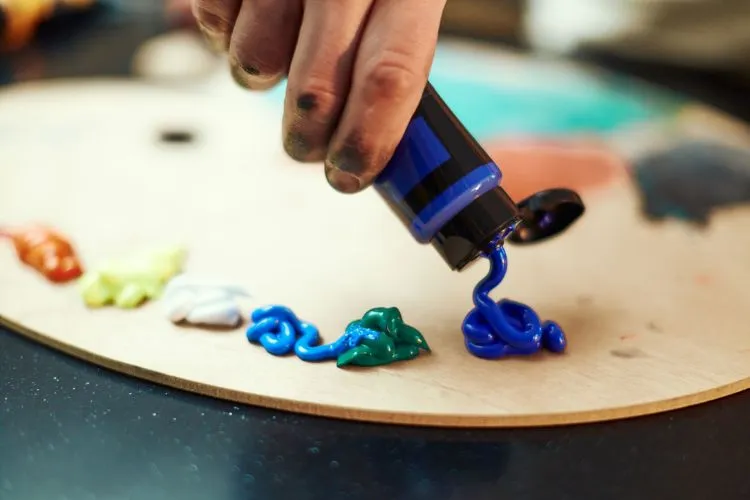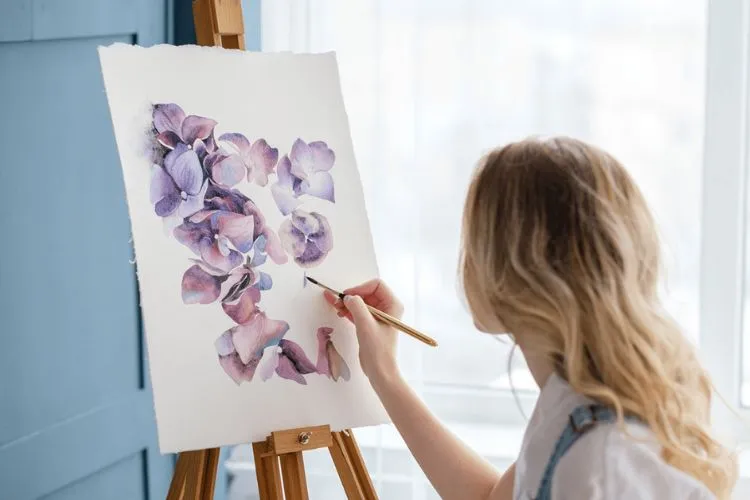When tackling home renovation or art projects, the question of longevity and maintenance of materials is a common concern. Among these considerations is the resistance of certain paints to mold growth. So, is acrylic paint mold resistant?
Acrylic paint, popular for its versatility and durability, often surfaces in discussions about mold-resistance properties. As a homeowner or artist, understanding the interplay between acrylic paint and mold is crucial for maintaining pristine walls and artworks.

Is Acrylic Paint Mold Resistant?
Acrylic paint is a water-based paint known for its quick drying time and versatility. It consists of pigment suspended in an acrylic polymer emulsion. But what does this mean in the context of mold resistance?
On one hand, the water-based nature of acrylic does not inherently promote mold growth any more than oil-based paints do. However, due to its porous nature when dried, if acrylic paint is applied in areas with high humidity or poor ventilation, it might not hold up well against mold.
A key detail to remember is that while acrylic paint on its own is not a haven for mold, without proper conditions and care, it is not invincible to it.
What Makes Paint Mold Resistant?
Mold thrives in damp environments, feeding on organic matter and spreading rapidly. The fight against mold begins with the molecular structure of a material.
Paints are formulated differently, and their mold-resistant capabilities hinge upon their composition, the additives they contain, and the conditions they’re exposed to after application.

Resistance to mold in paints is generally achieved through the inclusion of antimicrobial additives. These substances hinder the growth of mold spores and prevent their establishment on painted surfaces.
But knowing just what constitutes a mold-resistant paint is about more than recognizing a label; it’s about understanding its formulation.
Limitations of Acrylic Paint in Mold Prevention
Even the most robustly formulated acrylic paints have their limitations. Say you’ve painted a bathroom or a basement – areas notorious for damp conditions.
The paint must contend with moisture consistently. Over time, the protective film formed by the dried acrylic can break down, potentially allowing mold to penetrate.
Experts will point out that the longevity of acrylic paint’s mold-resistant qualities is finite. Real-world conditions such as fluctuating temperatures, exposure to sunlight, and varying degrees of moisture can all compromise its mold-resistant properties.
You may also like to find out: Is Acrylic Paint Eco Friendly?
Enhancing Mold Resistance in Acrylic Paint
There are a few strategies to enhance the mold-resisting power of acrylic paint:
- Preparation: Begin by ensuring that the surface to be painted is clean and free of existing mold. Use a mildewcide cleaner or a solution of bleach and water to scrub the area.
- Maintenance: Once the paint has been applied, maintenance is key. Regular cleaning can prevent mold spores from taking root. Also, address any moisture issues in the area – be it leaky pipes, condensation, or humidity.
- Environment: Enhance the longevity of your acrylic paint by controlling the environment. Improving ventilation, using dehumidifiers, or installing exhaust fans can keep the moisture in check.
Alternatives to Acrylic for High Moisture Areas
Sometimes, despite best efforts, acrylic may not be the best paint choice for areas prone to moisture. In such cases, looking into alternatives specifically designed for high moisture is wise.
Paints with a high gloss finish or oil-based paints have less permeability than acrylic and may serve as better barriers against mold. Moreover, some specialized paints are imbued with mold-inhibiting additives.
Safety Considerations When Combating Mold
When dealing with mold removal, ensuring personal safety and protecting environmental health are paramount.

Mold exposure can lead to health issues, ranging from mild allergic reactions to more severe respiratory problems. Here are essential safety considerations and guidelines:
Selecting the Right Protective Gear
- Respiratory Protection: Use an N-95 respirator or better to filter out mold spores during removal.
- Eye Protection: Wear goggles without ventilation holes to prevent spore entry.
- Skin Protection: Long gloves that extend to the middle of the forearm can guard against skin contact with mold and cleaning agents. Choose materials like natural rubber for water-based solutions.
Ensuring Proper Ventilation
- Air Flow: Open windows and doors to ensure good air circulation in the removal area. Avoid using fans if they spread mold to other areas.
- Air Filtration: Consider using air scrubbers or HEPA filters to capture airborne spores during and after the cleanup.
Safe Cleanup Practices
- Avoid Mixing Chemicals: Mixing cleaning agents (like bleach and ammonia) can release toxic fumes, posing significant health risks.
- Dust Suppression: Mist the moldy area lightly before cleaning to minimize the airborne spread of mold spores.
Disposal of Moldy Materials
- Secure Disposal: Encase mold-contaminated materials in plastic bags or sheets before removal to prevent dispersion of spores throughout your home.
- Appropriate Disposal Sites: Follow local regulations for disposing of moldy materials, ensuring they are taken to designated sites that can handle them properly.
Seeking Professional Help
- Assessment: For extensive mold infestation or if HVAC systems are affected, consulting a professional mold remediation service is advisable. They can assess and effectively remove mold with minimal health risks to occupants.
Implementing these safety precautions can help mitigate health risks associated with mold removal and ensure a safer environment for occupants and workers alike.
Frequently Asked Questions (FAQs)
Can mold grow in a paint can, and does it affect the paint’s quality?
Yes, if a paint can is stored improperly and moisture gets in, mold can grow inside it. This can compromise the paint’s quality and render it unusable.
How to identify and deal with mold in acrylic painted walls?
Mold on walls will appear as black, green, or white specks. To tackle mold, clean the area with a mold-killing solution, let it dry, and repaint with a mold-resistant paint.
Are there any mold-resistant additives for acrylic paint?
Yes, you can find additives to blend into the paint that enhance its mold-resistant properties. However, ensure they’re compatible with acrylic paint and follow the manufacturer’s instructions.
Choosing Mold-Resistant Acrylic Paints
To enhance the mold resistance of acrylic paints, it’s essential to choose high-quality products specifically formulated with mold-resistant properties. Here are some tips for selecting the right acrylic paint:
Look for Mold-Resistant Labels: When purchasing acrylic paint, look for labels or product descriptions that specifically mention mold resistance or antimicrobial properties.
These paints are formulated with additives that inhibit mold growth, providing an extra layer of protection.
Opt for High-Quality Brands: Reputable paint brands often invest in research and development to create products that offer superior performance, including mold resistance.
Choosing well-known brands can increase the likelihood of selecting a high-quality, mold-resistant acrylic paint.
Consult Product Reviews: Reading reviews and seeking recommendations from other users or professionals can provide insights into the effectiveness of specific acrylic paints in resisting mold.
Feedback from those who have used the product in similar environments can be valuable.
Consider Specialized Paints: Some acrylic paints are specifically designed for high-moisture areas, such as bathrooms and kitchens.
These paints typically contain enhanced mold-resistant additives and are formulated to withstand the challenges posed by humidity and moisture.
Applying Mold-Resistant Acrylic Paint
Proper application techniques can significantly impact the effectiveness of mold-resistant acrylic paint. Here are some guidelines to ensure optimal performance:
Surface Preparation: Thoroughly clean and prepare the surface before applying the paint. Remove any existing mold, dirt, or debris using a mold-killing solution. Allow the surface to dry completely before painting.
Priming: Applying a mold-resistant primer before painting can provide an additional barrier against mold growth. Primers enhance paint adhesion and create a smooth, even surface for the topcoat.
Multiple Coats: Applying multiple thin coats of acrylic paint can improve its durability and mold resistance. Ensure each coat is fully dry before applying the next layer.
Proper Ventilation: Ensure adequate ventilation during and after the painting process. Good airflow helps the paint dry evenly and reduces the risk of moisture accumulation, which can contribute to mold growth.
Long-Term Maintenance for Mold Prevention
Maintaining a mold-free environment requires ongoing efforts. Here are some long-term maintenance tips to keep acrylic-painted surfaces mold-resistant:
Regular Cleaning: Clean painted surfaces regularly to remove dust, dirt, and potential mold spores. Use mild, non-abrasive cleaners and avoid excessive moisture.
Humidity Control: Monitor and control humidity levels in areas prone to moisture, such as bathrooms, kitchens, and basements. Use dehumidifiers, exhaust fans, or air conditioning to keep humidity levels in check.
Prompt Repairs: Address any water leaks, condensation, or plumbing issues promptly to prevent moisture buildup. Fixing these problems early can prevent mold from taking hold.
Inspect and Repaint: Periodically inspect painted surfaces for signs of mold or wear. If you notice any mold growth or deterioration, clean the area and apply a fresh coat of mold-resistant acrylic paint.
Educate Household Members: Inform everyone in the household about mold prevention practices, such as using exhaust fans, wiping down wet surfaces, and avoiding prolonged exposure to moisture.
Conclusion:
The relationship between acrylic paint and mold is one of delicate balance. While acrylic paint on its own may not be mold’s worst enemy, with strategic use and careful environmental controls, it can hold the line against the relentless spores.
A knowledgeable application of paint, coupled with routine maintenance and smart environmental management, can keep walls and art gleaming and free of mold’s unsightly incursions.
It is by embracing a proactive approach that you can ensure the lasting beauty and integrity of acrylic-coated surfaces.

Meet Isabella Anderson, your acrylic painting mentor with over a decade of brush-wielding mastery. Dive into the colorful world of acrylics with her expert guidance, featured exclusively on ‘Acrylic Authority.’ Unleash your inner artist and explore the limitless possibilities of this versatile medium alongside a true acrylic aficionado.
